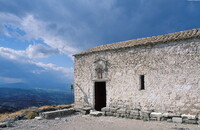Corinth; Acrocorinth [Ancient Greek and Roman site]
unknown (Greek (ancient))

Download1A2-G-AC-AO-D7_cp.jpg (638.7Kb)
Date
-680-1858Description
At the summit, view showing remains; Acrocorinth, the acropolis of Corinth, is a monolithic rock overseeing the ancient city of Corinth, Greece. It was continuously occupied from archaic times to the early nineteenth century. The city's archaic acropolis, already an easily defendable position due to its geomorphology, was further heavily fortified during the Byzantine Empire as it became the seat of the strategos of the Thema of Hellas. Later it was a fortress of the Franks after the Fourth Crusade, the Venetians and the Ottoman Turks. With its secure water supply [the spring, Upper Peirene, was housed within an underground chamber atop Acrocorinth] Acrocorinth's fortress was used as the last defending line in southern Greece repelling foes from entering the Peloponnesian peninsula. Three circuit walls formed the man-made defense of the hill. The highest peak on the site was home to a temple to Aphrodite [sanctuary of Aphrodite Hoplismene] which was Christianized as a church, then became a mosque. The American School began excavations on it in 1929. Currently, Acrocorinth is one of the most important medieval castle sites of Greece. [Source: Wikipedia] "From the 13th century settlement was again concentrated on Acrocorinth. The city was occupied by the Franks from 1210 and by the Ottomans from 1458, with an interlude of Venetian rule (1687-1715). The powerful defenses include Byzantine, Frankish, Venetian and Ottoman work. Acrocorinth was finally abandoned in the 19th century, and old Corinth was destroyed by an earthquake in 1858. The city of New Corinth was established about 5 km to the north-east." Source: Grove Art Online; http://www.groveart.com/ (accessed 2/2/2008)
Type of Work
excavation (site); fortificationSubject
architectural exteriors, Crusades, Ottoman Empire and its heritage, Roman Empire, Greek (ancient), Imperial (Roman)
Rights
Rights Statement
Licensed for educational and research use by the MIT community only